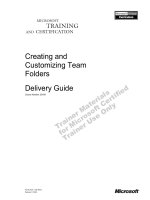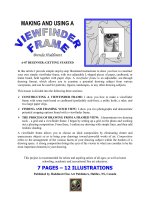Tài liệu Creating and Using a DataRelation Object doc
Bạn đang xem bản rút gọn của tài liệu. Xem và tải ngay bản đầy đủ của tài liệu tại đây (27.84 KB, 7 trang )
Creating and Using a DataRelation Object
In this section, you'll learn how to create a DataRelation object to define a relationship
between two DataTable objects that hold some rows from the Customers and Orders
tables. As you know, the CustomerID column of the child Orders table is a foreign key
that links to the CustomerID column of the parent Customers table.
Once you've created a DataRelation, you can use the GetChildRows() method of a
DataRow object in the parent DataTable to obtain the corresponding DataRow objects
from the child DataTable. By "corresponding," I mean the rows that have matching
values in the foreign key DataColumn objects. You can also use the GetParentRow()
method of a DataRow in the child DataTable to obtain the corresponding DataRow in the
parent DataTable.
Before creating and adding a DataRelation to a DataSet, you first need a DataSet. The
following example creates and populates a DataSet with two DataTable objects named
customersDT and ordersDT; notice that the top two rows from the Customers table along
with the corresponding rows from the Orders table are retrieved:
SqlCommand mySqlCommand = mySqlConnection.CreateCommand();
mySqlCommand.CommandText =
"SELECT TOP 2 CustomerID, CompanyName " +
"FROM Customers " +
"ORDER BY CustomerID;" +
"SELECT OrderID, CustomerID " +
"FROM Orders " +
"WHERE CustomerID IN (" +
" SELECT TOP 2 CustomerID " +
" FROM Customers " +
" ORDER BY CustomerID" +
")";
SqlDataAdapter mySqlDataAdapter = new SqlDataAdapter();
mySqlDataAdapter.SelectCommand = mySqlCommand;
DataSet myDataSet = new DataSet();
mySqlConnection.Open();
mySqlDataAdapter.Fill(myDataSet);
mySqlConnection.Close();
myDataSet.Tables["Table"].TableName = "Customers";
myDataSet.Tables["Table1"].TableName = "Orders";
DataTable customersDT = myDataSet.Tables["Customers"];
DataTable ordersDT = myDataSet.Tables["Orders"];
You'll see how to create a DataRelation that defines a relationship between the
customersDT and ordersDT DataTable objects next.
N
ote You'll find all the code examples shown in this section in the
CreateDataRelation.cs program.
Creating the DataRelation
The DataRelation constructor is overloaded as follows:
DataRelation(string dataRelationName,
DataColumn parentDataColumn, DataColumn childDataColumn)
DataRelation(string dataRelationName,
DataColumn[] parentDataColumns, DataColumn[] childDataColumns)
DataRelation(string dataRelationName,
DataColumn parentDataColumn, DataColumn childDataColumn, bool
createConstraints)
DataRelation(string dataRelationName,
DataColumn[] parentDataColumns, DataColumn[] childDataColumns,
bool createConstraints)
DataRelation(string dataRelationName,
string parentDataTableName, string childDataTableName,
string[] parentDataColumnNames, string[] childDataColumnNames,
bool nested)
where
• dataRelationName is the name you want to assign to the RelationName property
of your DataRelation.
• parentDataColumn and parentDataColumnsare the DataColumn objects in the
parent DataTable.
• childDataColumn and childDataColumns are the DataColumn objects in the
child DataTable.
• createConstraints indicates whether you want a UniqueConstraint added to the
parent DataTable and a ForeignKeyConstraint added to the child DataTable
automatically (the default is true).
• parentDataTableName and childDataTableName are the names of the parent and
child DataTable objects.
• parentDataColumnNames and childDataColumnNames contain the names of the
DataColumn objects in the parent and child DataTable objects.
• nested indicates whether the relationships are nested.
The following example creates a DataRelation object named customersOrdersDataRel:
DataRelation customersOrdersDataRel =
new DataRelation(
"CustomersOrders",
customersDT.Columns["CustomerID"],
ordersDT.Columns["CustomerID"]
);
The name assigned to the RelationName property of customersOrdersDataRel is
CustomersOrders, the parent DataColumn is customersDT.Columns["CustomerID"], and
the child DataColumn is ordersDT.Columns["CustomerID"].
Next, customersOrdersDataRel must be added to myDataSet. You access the
DataRelation objects in a DataSet object through its Relationships property. The
Relationships property returns an object of the DataRelationCollection class, which is a
collection of DataRelation objects. To add a DataRelation object to the
DataRelationCollection object of a DataSet, you call the Add() method through the
Relationships property of your DataSet.
The following example uses the Add() method to add customersOrdersDataRel to
myDataSet:
myDataSet.Relations.Add(
customersOrdersDataRel
);
The Add() method is overloaded, and you can also use the following version of the Add()
method to create and add a DataRelation object to myDataSet:
myDataSet.Relations.Add(
"CustomersOrders",
customersDT.Columns["CustomerID"],
ordersDT.Columns["CustomerID"]
);
This example does the same thing as the two earlier examples. The first parameter to the
Add() method is a string containing the name you want to assign to the RelationName
property of the DataRelation. The second and third parameters of the relationship are the
DataColumn objects from the parent and child DataTable objects.
Examining the Constraints Created by the DataRelation
By default, when you create a DataRelation, a UniqueConstraint and
ForeignKeyConstraint are automatically added to your parent and child DataTable
objects. You can get the UniqueConstraint from a DataRelation using its
ParentKeyConstraint property. For example:
UniqueConstraint myUC =
customersOrdersDataRel.ParentKeyConstraint;
You can view the properties of the myUC UniqueConstraint object using the following
code:
Console.WriteLine("Columns:");
foreach (DataColumn myDataColumn in myUC.Columns)
{
Console.WriteLine("" + myDataColumn);
}
Console.WriteLine("myUC.ConstraintName = " + myUC.ConstraintName);
Console.WriteLine("myUC.IsPrimaryKey = " + myUC.IsPrimaryKey);
Console.WriteLine("myUC.Table = " + myUC.Table);
The output from this code is as follows:
Columns:
CustomerID
myUC.ConstraintName = Constraint1
myUC.IsPrimaryKey = False
myUC.Table = Customers
You can get the ForeignKeyConstraint from a DataRelation using its ChildKeyConstraint
property. For example:
ForeignKeyConstraint myFKC =
customersOrdersDataRel.ChildKeyConstraint;
You can view the properties of myFKC using the following code:
Console.WriteLine("myFKC.AcceptRejectRule = " + myFKC.AcceptRejectRule);
Console.WriteLine("Columns:");
foreach (DataColumn myDataColumn in myFKC.Columns)
{
Console.WriteLine(""+ myDataColumn);
}
Console.WriteLine("myFKC.ConstraintName = " + myFKC.ConstraintName);
Console.WriteLine("myFKC.DeleteRule = " + myFKC.DeleteRule);
Console.WriteLine("RelatedColumns:");
foreach (DataColumn relatedDataColumn in myFKC.RelatedColumns)
{
Console.WriteLine("" + relatedDataColumn);
}
Console.WriteLine("myFKC.RelatedTable = " + myFKC.RelatedTable);
Console.WriteLine("myFKC.Table = " + myFKC.Table);
Console.WriteLine("myFKC.UpdateRule = " + myFKC.UpdateRule);
The output from this code is as follows:
myFKC.AcceptRejectRule = None
Columns:
CustomerID
myFKC.ConstraintName = CustomersOrders
myFKC.DeleteRule = Cascade
RelatedColumns:
CustomerID
myFKC.RelatedTable = Customers
myFKC.Table = Orders
myFKC.UpdateRule = Cascade
The DeleteRule and UpdateRule properties are set to Cascade by default. Because
DeleteRule is set to Cascade, when you delete a DataRow in the parent DataTable, then
any corresponding DataRow objects in the child DataTable are also deleted. Because
UpdateRule is set to Cascade, when you change the DataColumn in the parent DataTable
on which the ForeignKeyConstraint was created, then the same change is also made in
any corresponding DataRow objects in the child DataTable. You'll learn more about this
later in the section "Issues When Updating the Primary Key of a Parent Row."
Navigating DataRow Objects in the Parent and Child DataTable Objects
To navigate the DataRow objects in related DataTable objects, you use the
GetChildRows() and GetParentRows() methods of a DataRow.
Using the GetChildRows() Method
You use the GetChildRows() method to get the related child DataRow objects from the
parent DataRow. For example, the following code displays the parent DataRow objects
from the customersDT DataTable and their related child DataRow objects from the
ordersDT DataTable:
foreach (DataRow customerDR in customersDT.Rows)
{
Console.WriteLine("\nCustomerID = " + customerDR["CustomerID"]);
Console.WriteLine("CompanyName = " + customerDR["CompanyName"]);
DataRow[] ordersDRs = customerDR.GetChildRows("CustomersOrders");
Console.WriteLine("This customer placed the following orders:");
foreach (DataRow orderDR in ordersDRs)
{
Console.WriteLine("OrderID = " + orderDR["OrderID"]);
}
}
The output from this code is as follows:
CustomerID = ALFKI
CompanyName = Alfreds Futterkiste
This customer placed the following orders:
OrderID = 10643
OrderID = 10692
OrderID = 10702
OrderID = 10835
OrderID = 10952
OrderID = 11011
CustomerID = ANATR
CompanyName = Ana Trujillo Emparedados y helados
This customer placed the following orders:
OrderID = 10308
OrderID = 10625
OrderID = 10759
OrderID = 10926
Using the GetParentRow() Method
You use the GetParentRow() method to get the parent DataRow from the child DataRow.
For example, the following code displays the first child DataRow from ordersDT and its
related parent DataRow from customersDT:
DataRow parentCustomerDR = ordersDT.Rows[0].GetParentRow("CustomersOrders");
Console.WriteLine("\nOrder with OrderID of " + ordersDT.Rows[0]["OrderID"] +
" was placed by the following customer:");
Console.WriteLine("CustomerID = " + parentCustomerDR["CustomerID"]);
The output from this code is as follows:
Order with OrderID of 10643 was placed by the following customer:
CustomerID = ALFKI









